Important For Kids:
How To Interact Safely With Dogs
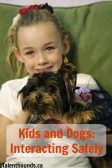
We all love dogs and when we’re out and about and see a real cutie, it’s easy to forget that not all dogs are sociable. Kilo the Pug looks little and sweet (as most pugs are) but he panics if he sees a stranger’s hand coming from above towards him. He is especially afraid of certain men and could snap. Whether it’s your own dog someone else wants to pet or one you see in the park, it’s important to understand how to interact safely. This means knowing what warning signs to look out for to recognize aggressive or defensive behavior that could put you or your child or a dog at risk.
Obtain Permission Before Anything Else
It’s always best to ask the owner before interacting with a dog other than your own. I always thank kids and adults who do so with Kilo. If the owner is not around, it’s probably better to just leave that dog be.
By asking first, you give the owner the opportunity to let you know how their dog will react and this protects all involved.
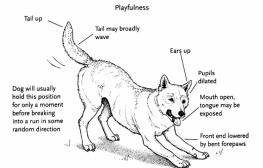
Some dogs might not react well to kids, some dogs might love kids but not do well with other dogs, and some dogs may be perfectly friendly but are also the type of dog who will jump up to lick your face which could be scary or dangerous if you’re not expecting it, especially for small children. If you take a moment to check in with the owner before letting your child pet any dog, you can help avoid the risk of being bitten.
6 Quick Tips
Unfortunately not every situation is straight forward, even after obtaining permission to approach and pet a dog. There are a few things you can do to make sure the dog is as comfortable as possible and doesn’t accidentally perceive you or your child as a threat:
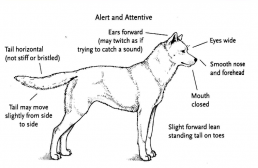
- Avoid making hard, unbroken eye contact with the dog. Averting your gaze to the side or blinking slowly shows the dog that you are letting your guard down, whereas staring directly into a dog’s eyes can be perceived as confrontational and threatening in the animal kingdom.
- Let the dog get a whiff of your scent before touching. Offering your hand for the dog to sniff shows them that you are trying to let them get to know you (because as we know dogs rely heavily on scent as one of their strongest senses.) With most dogs, a relaxed fist and/or upturned palm below their head is best because an open palm coming down over their heads may make some dogs like Kilo feel on edge.
- Kneel down and get on the dog’s level, turning your body slightly away from them. Similarly to offering your hand from below, getting down low with the dog lets them know you aren’t trying to assert dominance. Turning your body away, like closing your eyes, shows them that you’re trusting them rather than challenging.
- Once the dog has given you a sniff it is best to still keep your hand below their head. So, a scratch under the chin, or a pet on the chest or side of the head is a great way to initiate touch. Now, if when you go to pet the dog they pull away, it’s likely you just didn’t give them enough time to take in your scent and non-threatening posture, so have some patience, offer your hand again for them to smell more and DO NOT keep trying to pet a dog that is pulling away or chase or grab a dog that doesn’t want to be petted.
- Dogs on a leash may feel trapped or pressured to interact but not want to, so it’s important to acknowledge this and leave them be. Dogs behind fences or in crates (even if it’s your own dog) may feel territorial and it’s best to not let your child ever try to pet a dog through a fence or in a cage.
- This also applies to dogs who are caring for puppies, sleeping or eating. Leave these dogs be as they are much more likely to get defensive and that can turn to aggression quickly.
Supervision is Key
All of these rules can and should be applied even with your own dog at home and children (especially young ones) should never be left unattended to play with a dog. Even if you’d trust that dog with your life, it’s not worth putting your child or the dog at risk. It is also equally important to teach your dog and child how to respect one another. Even the nicest of dogs can get annoyed with a child pulling on their tail or ears, or poking their eyes, so make sure your child understands to be gentle and that your dog might need some space sometimes and that’s okay. Taking toys or food from a dog or rough housing can also lead to danger.
Physical Indicators of Dog Aggression/Passivity
If you’ve followed all these guidelines you’ve likely done your very best to make that dog feel comfortable and at ease. However because dogs don’t have the ability to tell us explicitly when something is wrong, there are physical signs that you can watch out for, and teach your child to recognize that may alert you to how a dog is feeling in a given situation.
These images are taken from the Federal Emergency Management Agency (FEMA) Community Emergency Response Team (CERT) training Module I on Animal Response:
Signs of Aggression:
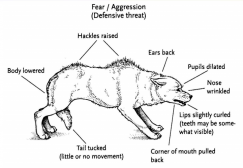
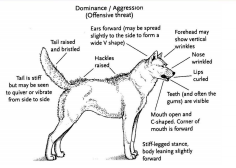
Signs of Fear/ Submission
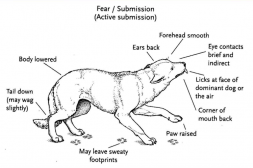
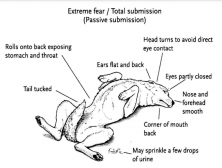
Teaching Kids How To Say Hello To A Dog
We sat down with Sarah L. Parker (a.k.a. Sadie) to get the inside scoop on her must-read children’s book “Henry Says Hello”. Sadie talks about why she decided to write the book, why it’s important to teach our kids about safely approaching dogs (both out and about and at home), and gives a few insights into the important steps kids can take to ensure that safety.
Check out our review of S.L. Parker’s must-read children’s book “Henry Says Hello” HERE.
Please note we are not veterinary professionals or trainers or behaviorists, we are just sharing our own personal experience and research.
If you’d like more information on Dog Bite Prevention check out our other article from National Dog Bite Prevention week HERE.

Well detailed post! Thanks for sharing!
Great post! So many adults don’t have a clue how their kids should aproach dogs (or not) these days!
Mr. N is a kid magnet so we run into this a lot. I tell the kids to not pet his head because they like to go over his eyes. And to sit down and pet him from the side.
This is so important. I’m amazed at how many people, both kids & adults, will come bounding over to Pet my dogs without asking if it’s OK. This book sounds terrific, every library & school should have it! I love the FEMA diagrams, every school should have that too!
Love & biscuits,
Dogs Luv Us and We Luv Them
I also think that parents need to realize that just like anything else – kids need to hear this over and over again. They can’t be expected to learn all this at once. It’s not a one and done thing and learning how to engage safely with dogs is an ongoing process.
I’m going to tweet this out as well.
These are great tips. I’d even say these tips would work well for first time dog owners.
Important article; such information should be widely available.
Dogs are not toys, kins needs to realise this, so do their parents.
The parents need educating and this is critical, then the kids learn from them so it’s great to see images not just words. What works, what doesn’t – what dog’s like, what they don’t. I am not a dog person, but I would never approach a strange dog without permission.
These are great tips! I believe that many dog bites are preventable. There is a little girl down the street from me who loves dogs! I am pretty sure her first words were “can I pet your dog?” She always asks, even about dogs she is always allowed to pet. And when someone says “sorry, no,” she accepts it without an issue.
my wee Chi has dominance aggression to kids under 12. A little girl hurt him as a puppy (pulled his fur off his wee wee to bleeding point in one fast motion ACK!!) so now we are hyper cautious with kids.
Great tips. I love kids and dogs. I’m currently writing a kids and dog book. These are such important topics to cover. Thanks for the post.
It’s so important for children to be aware of these things, and adults as well. Great post!
It is so important for parents to teach their children how to interact with dogs and other domestic animals. Dogs have thoughts and feelings all their own! I agree that one of the biggest factors is supervision. You can never truly 100% trust an animal not to become aggressive with a child. Children don’t always know how to interpret the communication that the animal is conveying.
This is such great and important information! It seems like I’m always hearing about a child who got bit or attacked by a dog, and I always wonder if it could have been prevented by the humans knowing information like this.
This is great! We need to teach children how to love and respect dogs and not put them in situations where they fear them.